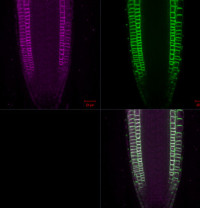1

Anti-PIN2 | Auxin efflux carrier component 2 (polyclonal)
AS20 4521 | Clonality: Polyclonal | Host: Rabbit | Reactivity: Arabidopsis thaliana
- Product Info
-
Immunogen: KLH-conjugated mixture of two synthetic peptides derived from AtPIN2 sequence, UniProt:Q9LU77, TAIR:At5g57090 Host: Rabbit Clonality: Polyclonal Purity: Immunogen affinity purified serum in PBS pH 7.4. Format: Lyophilized Quantity: 50 µg Reconstitution: For reconstitution add 50 µl, of sterile water Storage: Store lyophilized/reconstituted at -20°C; once reconstituted make aliquots to avoid repeated freeze-thaw cycles. Please remember to spin the tubes briefly prior to opening them to avoid any losses that might occur from material adhering to the cap or sides of the tube. Tested applications: Immunolocalization (IL) Recommended dilution: 1 : 200 (IL) Expected | apparent MW: 69.3 kDa - Reactivity
-
Confirmed reactivity: Arabidopsis thaliana Predicted reactivity: Beta vulgaris, Brassica napus, Camelina sativa, Cannabis sativa, Capsella rubella, Cucumis melo, Eucalyptus grandis, Eutrema salsugineum, Glycine max, Malus domestica, Morus notabilis, Prunus dulcis, Raphanus sativus, Spinacia oleracea, Vitis vinifera
Species of your interest not listed? Contact usNot reactive in: Lemna minor, Zea mays - Application Examples
-

Left panel: epidermal layer of the root shown polar PIN2 localization.
Right panel: The PIN2 signals were restricted only to cortex, epidermis and root caps.
Material: Arabidopsist thaliana young seedling-5-day-old roots.
Fixation: 2 % Formaldehyde in Microtuble-stabilizing buffer stock solution (50 mM PIPES, 5 mM EGTA, 2 mM MgSO4, 0.4 % Triton), vacuum for 3 min. and fixation conducted for 40 min.
Washing buffer: Microtuble-stabilizing buffer stock solution (50 mM PIPES, 5 mM EGTA, 2 mM MgSO4, 0.4 % Triton)
Primary antibody: 1: 200
Secondary antibody: anti-rabbit (1:250): (Rhodamine Red™-X (RRX) AffiniPure Donkey Anti-Rabbit IgG (H+L)/Jackson ImmunoResearch/ Cat# 711-295-152)
And the unique signal pattern colocalized with PIN2-GFP marker line (in green). The PIN2 signal is not visible in the middle of a root tissue, where PIN2 protein does not occur (negative control).
Material: Arabidopsist thaliana young seedling-5-day-old roots.
Fixation: 4 % Formaldehyde in 1×Phosphate buffered saline (PBS) (4g NaCl, 0.115g NaH2PO4•H2O, 0.695g Na2HPO4•2H2O, 0.1g KCl in 1L ddH2O, pH 7.4) supplement with 0.1% TritonX, vacuum for 1 hour, and fixation conducted for 1 hour.
Washing buffer: 1×Phosphate buffered saline (PBS)
Blcoking buffer: 3% BSA (Carl Roth, cat. No. 8076.3) in 1×PBS
Primary antibody: 1: 500 ON/4ºC
Secondary antibody: anti-rabbit (1:500), Alexa Fluor 568 (Invitrogen, A11011).Courtesy SHEN Jinbo Zhejiang Agricultural & Forestry University, Hangzhou, Zhejiang, China
- Background
-
Background: Arabidopsis thaliana auxin efflux carrier component AtPIN2 encoded by the AtPIN2 gene (also known as EIR1 and AGR1). AtPIN proteins are asymmetrically localized within plant plasma membranes and mediate polar auxin transport. AtPIN2 is a key regulator of the response of Arabidopsis roots to gravity. Alternative names: Auxin efflux carrier AGR, Ethylene-insensitive root 1, AtEIR1, Polar-auxin-transport efflux component AGR1, Protein AGRAVITROPIC 1, AtAGR1, Protein WAVY 6. - Product Citations
-
Selected references: To be added when available. Antibody released in 2021. - Protocols
-
Agrisera Western Blot protocol and video tutorials
Protocols to work with plant and algal protein extracts
Agrisera Educational Poster Collection - Reviews:
-
This product doesn't have any reviews.
Accessories

AS21 4600 | Clonality: Monoclonal | Host: Mouse | Reactivity: Arabidopsis Thaliana
Interested in receiving a free sample for testing? Contact us.

AS07 260 | Clonality: Polyclonal | Host: Rabbit | Reactivity: [global antibody] for di- and monocots, conifers, ferns, mosses, green algae | Cellular [compartment marker] for plasma membrane
Benefits of using this antibody

